Lenin - Chapter II
Chapter II
In 1904 Russia rather unwisely went to war with Japan. This conflict had a profound impact on Russian society. After a number of crushing and humiliating defeats, citizens from all walks of life began to voice their discontent over the country's political structure and called for reform. This exacerbated the economic crisis that the country had been heading towards since four years. The failure of the land reforms of the early 1900s had led to increasing peasant disturbances and revolts, with the goal of securing ownership of their land. The rapid industrialization of Russia also resulted in urban overcrowding and poor conditions for urban industrial workers. Between 1890 and 1910, the population of the capital of St. Petersburg rose and almost doubled, with Moscow experiencing similar growth. Strikes and demonstrations erupted in many parts; Russia was heading towards an outright collapse.
On 9th January, 1905, a group of unarmed workers including women and children, in St. Petersburg peacefully took their concerns directly to the city's palace to submit a petition to Emperor Nicholas II for the granting of civil rights. They were met by security forces, who ordered them to disperse, and when they did not heed, fired on the group. A great number of innocent demonstrators were killed and wounded. This massacre outside the Winter Palace, transformed the situation and the consequence of "Bloody Sunday" as it came to be called, was irrevocable. Violence and disorder swept through the
country. This incident sparked a series of events that became known as the 1905 Revolution.
The news of the Russian revolutionary crisis reached Geneva the day after the massacre in St. Petersburg, where throughout the day "... the sedate streets of Geneva resounded with the shouts of newspaper boys — Revolution en Russie!..."1 Lenin (who was in Geneva) and other underground revolutionaries were in a state of shock and excitement and the feeling of many was that they had to return to Russia. Lenin, however, was not yet ready to go, in spite of exhortations from top revolutionaries; he believed as a revolutionary leader he should not risk his personal safety.
Strikes took place all over the country, the universities closed down and there were mutinies in the army and the navy. Vociferous complaints about the lack of civil liberties and demands for a constituent assembly and an end to absolute rule were raised by Russians from all walks of life.
In October, events again exploded in Russia and after a general strike, workers took events in their own hands and with the help of Mensheviks set up the St. Petersburg Soviet, an elected committee. Many such soviets sprang up in different parts of Russia. A shaken yet hesitant Nicholas II was forced to agree to political change and in order to placate his citizens, signed the October Manifesto, pledging a constitution, an extended franchise, and civil liberties, most notably the creation of an elected legislative assembly known as the Duma. Soon after the proclamation of the manifesto strikes ended and civil unrest abated and there were even some demonstrations of support in the cities. However, the next month saw another general strike as Russians felt that the reforms were insufficient and the Duma was merely a consultative body. Trotsky, who had meanwhile returned to Russia and joined the St. Petersburg Soviet, was arrested along with other members of the St. Petersburg Soviet in December, 1905.
A question frequently asked is why did Lenin fail to seize the moment and head back for Russia? When he did return to
1. Helen Rappaport, Conspirator: Lenin in Exile, p. 120.
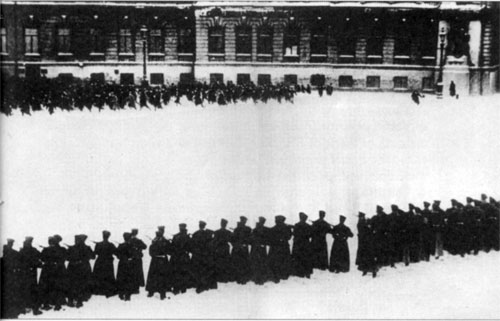 Bloody Sunday, 22nd January 1905. A petition was taken to Tsar at the St. Petersburg Winter Palace. The people were mown down.
Bloody Sunday, 22nd January 1905. A petition was taken to Tsar at the St. Petersburg Winter Palace. The people were mown down.
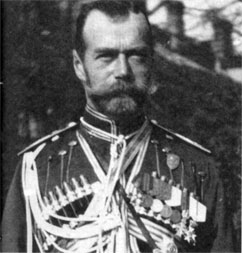 The Tsar Nicholas II
The Tsar Nicholas II
St. Petersburg in November 1905, the moment had passed. That none of the émigré political activists took advantage of the moment was largely because Russia had seen many protests and incidents of civil unrest come up before and subsequently come to nought, so there was neither belief nor readiness for action.
Though the revolutionary movement failed to achieve immediate success, Lenin continued working tirelessly between 1907 and the outbreak of World War I. He settled first in Switzerland, where he edited the Social Democrats' new party newspaper, Proletary, for some time, and supervised the smuggling of it into Russia.
The fifth party congress held in London, in 1907, was the largest till then. The intellectuals were still in majority in the RSDLP, but the party ranks now included over one hundred representatives from Russia's burgeoning urban working classes. Lenin is said to have taken centre stage from the outset. His friend, the writer, Maxim Gorky, was struck by his persuasive arguments;
For [Maxim] Gorky, as for many others during those three weeks in May, Lenin's greatness lay in his direct manner. He had the ability to breathe life and logic into complex political questions, treating them "so simply, no striving after eloquent phrases... but every word uttered distinctly, and its meaning marvelously plain."1
However, the ongoing disagreement between the Bolsheviks and the Mensheviks continued. The Bolsheviks thought that only a violent uprising in the proletariat could truly create a communist state, the rebellion headed by a small number of intelligent revolutionaries. For the Mensheviks gradual reform and democracy were what would take Russia forward into communism and with the formulation of parties and a parliament, the workers would then be empowered.
Lenin however, was not "content to wait while history took its predetermined course." Instead, he argued, a real and complete
1. Helen Rappaport, Conspirator: Lenin in Exile, pp.161.
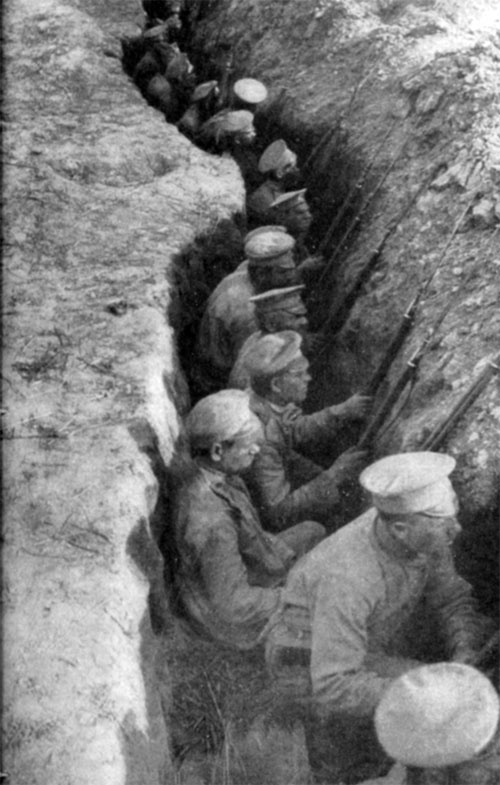 Russian troops in trenches during World War I, facing Germans
Russian troops in trenches during World War I, facing Germans
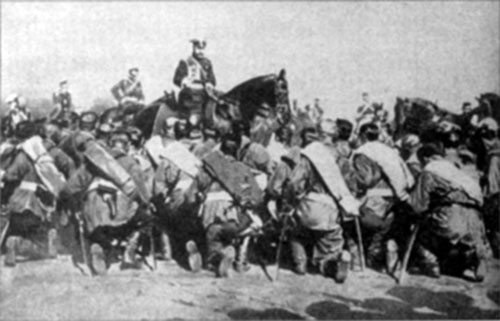 The Tsar visiting the troops during Wold War I
The Tsar visiting the troops during Wold War I
revolution, one that could lead to Socialist Revolution that could spread outside of Russia, must be through the united leadership of the urban proletariat and the peasantry. The Mensheviks argued against Lenin's centralized, dictatorial party model. From their point of view, Lenin's ideas led the way towards a one-man dictatorship over the people whom he actually wanted to empower.
The fighting between the Bolsheviks and the Mensheviks would continue until a 1912 party conference in Prague where at Lenin's urging, the delegates voted to break away from the Social Democrats and to form a separate socialist party. From that point the Bolsheviks and Mensheviks existed as separate political entities.
From 1911 onwards there was a resurgence of working-class militancy and large scale strikes became common in the two major cities of St. Petersburg and Moscow culminating in July 1914, when the capital was paralysed by a general walk-out and workers and police fought hand-to-hand battles.
It was only with the outbreak of World War I on August 1 that revolutionary fervor subsided and it seemed that the war forged a new bond between Sovereign and people. The bond would not remain intact for long; in fact World War I was to prove the undoing of tsarist rule. During World War I, Lenin was in exile again, and residing in Switzerland. As always, his mind stayed focused on revolutionary politics. During this period, in 1916, he wrote and published Imperialism, The Highest Stage of Capitalism.
It was his task, Lenin tells us in State and Revolution, "to resuscitate the real teachings of Marx." He sought to do this... by insisting that progress towards Socialism could only be revolutionary, not evolutionary as Bernstein and the revisionists maintained...
... He was one of the greatest revolutionary strategists of all time, and nothing is more typical of him than his unequivocal insistence on the necessity of revolution... It was Lenin's... great task to adapt Marxism to Russia. As a Russian of the Russians who need yield place to no one in Russian history in his instinctive understanding
of Russian realities, and as a revolutionary strategist of genius, he realized that in certain circumstances revolution is possible in Russia. Those circumstances were Tsarist defeat in war and the existence to take advantage of it of a resolute, highly disciplined group of professional revolutionaries, limited in number... His interpretation of Marx convinced him that war was inevitable. His knowledge of Russia convinced him that Russian defeat was inevitable. Therefore it was for him to create the party which would carry the revolution through to its successful conclusion.1
The war was a disaster for Russia. By the summer of 1915, Russian casualties had reached an astronomical figure and huge areas of the empire were under German occupation.
The tsarist government, through its prodigious incompetence, seemed to pose almost as great a threat as the Germans. Every item of equipment was in short supply. Many men were sent to the front without boots, without proper clothing, and sometimes even without rifles.2
As the war continued to go badly for the Russians with one military defeat after another compounded by the loss of territory and the extreme food shortages, there was increasing unrest in the cities. Despair gained ground as public confidence in the Tsar diminished alarmingly. As the power of the imperial regime diminished, Vladimir Lenin rose to prominence as the most powerful figure in Russia.
* * *
- C.L.Wayper, Political Thought, pp. 221, 223.
- The World in Arms, History of the World, Time-Life Series, pp. 60-1.
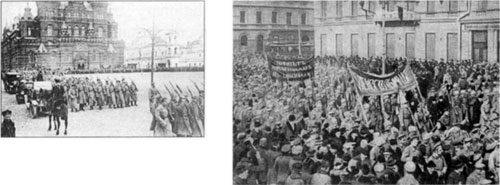 Left : Russion soldiers marching in Petrograd in February 1917. Right : Soldiers demonstrations, 1917.
Left : Russion soldiers marching in Petrograd in February 1917. Right : Soldiers demonstrations, 1917.
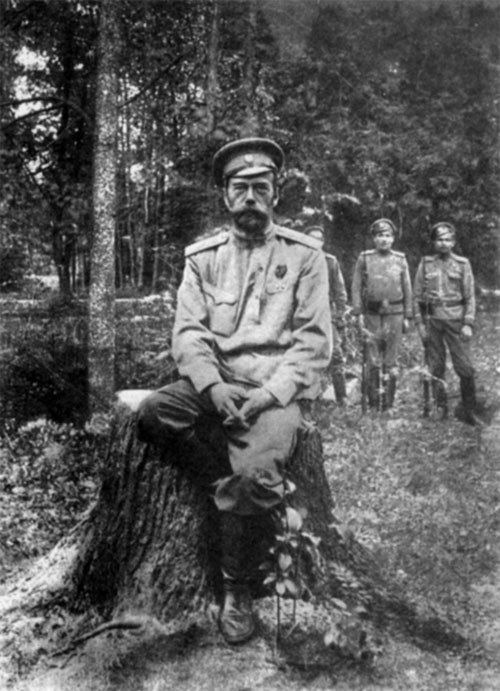 One of the last photos of the Tsar
One of the last photos of the Tsar
Related Books
- Alexander the Great
- Arguments for The Existence of God
- But it is done
- Catherine The Great
- Danton
- Episodes from Raghuvamsham of Kalidasa
- Gods and The World
- Homer and The Iliad - Sri Aurobindo and Ilion
- Indian Institute of Teacher Education
- Joan of Arc
- Lenin
- Leonardo Da Vinci
- Lincoln Idealist and Pragmatist
- Marie Sklodowska Curie
- Mystery and Excellence on The Human Body
- Nachiketas
- Nala and Damayanti
- Napoleon
- Parvati's Tapasya
- Science and Spirituality
- Socrates
- Sri Krishna in Brindavan
- Sri Rama
- Svapnavasavadattam
- Taittiriya Upanishad
- The Aim of Life
- The Crucifixion
- The Good Teacher and The Good Pupil
- The Power of Love
- The Siege of Troy
- Uniting Men - Jean Monnet